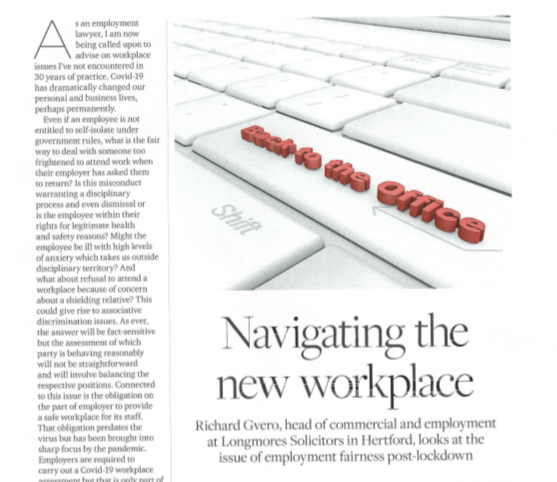Navigating The New Workplace
As an employment lawyer, I am now being called upon to advise on workplace issues I’ve not encountered in 30 years of practice. Covid-19 has dramatically changed our personal and business lives, perhaps permanently.
Even if an employee is not entitled to self-isolate under government rules, what is the fair way to deal with someone too frightened to attend work when their employer has asked them to return? Is this misconduct warranting a disciplinary process and even dismissal or is the employee within their rights for legitimate health and safety reasons? Might the employee be ill with high levels of anxiety which takes us outside disciplinary territory? And what about refusal to attend a workplace because of concern about a shielding relative? This could give rise to associative discrimination issues. As ever, the answer will be fact-sensitive but the assessment of which party is behaving reasonably will not be straightforward and will involve balancing the respective positions. Connected to this issue is the obligation on the part of employer to provide a safe workplace for its staff. That obligation predates the virus but has been brought into sharp focus by the pandemic. Employers are required to carry out a Covid-19 workplace assessment but that is only part of the equation. In some workplaces it is going to be extremely difficult to implement social distancing on account of office size and staff numbers as well as how a business operates, so adequate PPE will be the issue. If the employer is adjudged to have not provided a safe workplace, there is the real potential for substantial legal claims.
Many businesses have been seriously damaged by the crisis and have little prospect of recovery in the short term. From a staffing perspective, this may mean redundancies. Can these be implemented during the operation of the government’s job retention scheme, which will operate albeit in altered form until the end of October? Yes, they can but the question arises as to whether it is fair to make staff redundant at a time when they can be on furlough at no cost to the employer? Arguably not, because furlough leave will be a reasonable alternative to redundancy in some cases. Also, if an employee is not on furlough and is made redundant can they be placed on furlough to mitigate notice pay costs? This scenario is not expressly dealt with in the guidance but is likely to be contrary to the objectives of the scheme: to preserve employment.
Finally, a common question is whether employees on furlough can be forced to take holiday so that businesses are not faced with returning employees all wanting to catch up on holiday. The guidance tells us they can but subject to a tricky assessment of whether, in the context of lockdown, self-isolation and social distancing, holiday is feasible. But we are not guided on how to make that assessment. Arguably, an employer infringes the work time regulations by forcing staff to take holiday at a time when this makes no difference to them and they cannot have a ‘proper’ holiday anyway.
This is clearly a surreal time for our workplaces with many difficult questions being posed and answers not always easy to come by. In the face of uncertainty, some risk will need to be taken but more so than ever, a measured and careful approach is advisable.
Here to Help
If you need employment advice for your business, get in touch with Richard Gvero, Joint Senior Partner and Head of Employment.
Please note the contents of this blog are given for information only and must not be relied upon. Legal advice should always be sought in relation to specific circumstances.
Written for Hertfordshire Life, July 2020.
NLA article not to be reproduced

